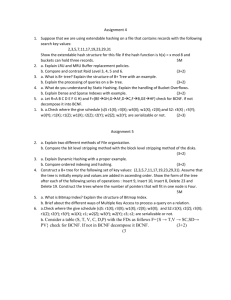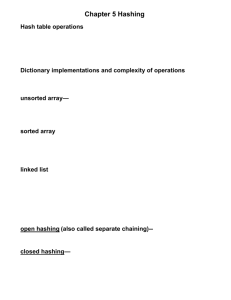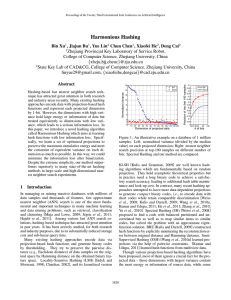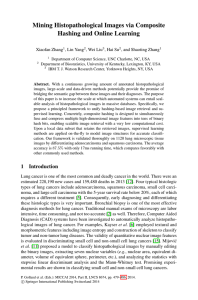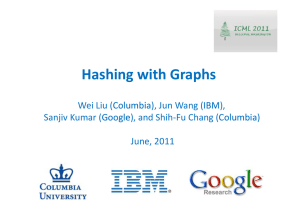d - CSIE -NCKU
advertisement
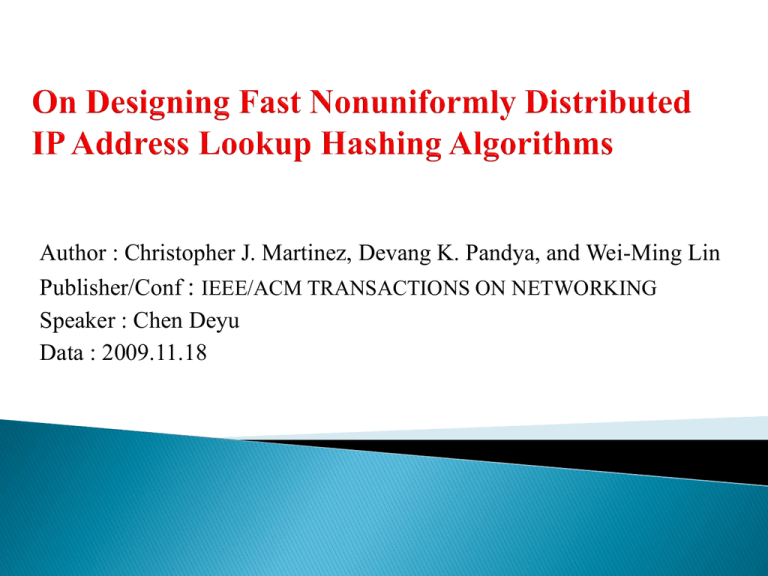
Author : Christopher J. Martinez, Devang K. Pandya, and Wei-Ming Lin Publisher/Conf : IEEE/ACM TRANSACTIONS ON NETWORKING Speaker : Chen Deyu Data : 2009.11.18 Hashing for address lookup Simulation setup Proposed hashing algorithms Preprocessing of database XOR Hashing d-value-Based XOR Folding Hashing d-value-Based Natural-Folding XOR Hashing Simulation results Randomly Generated Data Set Real IP-Address Data set Implementation Hashing value Database (Data set) m A system is assumed to have a database of 2 entries, each of which contains a key of n bits to be used for hashing into bits. Two widely used performance measurements are adopted in this paper: 1. Maximal Search Length (MSL) Average Maximal Search Length (ASL) 2. Data sets are generated either randomly or extracted from real IP traffic. Assume m=3 and n=8, so database has 8 entries, each of entries has 8bits, and hashing value has 3 bits. An immediate benefit from this preprocessing step can be demonstrated by observing the performance difference between applying a simple bit-extraction hashing process on the non-preprocessed database and the preprocessed one. Group-XOR is a commonly used hashing technique by simply grouping the n-bit key into m-bit hash result through a simple process XORing every n/m key bits into a final hash bit. Such a random XORing process (so-called“group-XOR” in this paper) may not always lead to a desirable outcome. Key a b c a b c XOR XOR XOR To precisely quantify the benefit when XORing two bit vectors with their d values being di and dj, a formula can be derived to find the expected resultant d for the new bit vector after XORing, denoted as ddi d j xj C xxij k CkM xi k 0 C xMj d d i d j M 2 4k where xi M dj M di , xj , xi x j 2 2 This equation is derived by taking into account all possible combinations of the two bit vectors with di and dj. Assume key has 8bits and hashing value has 3 bits. To further exploit the somewhat symmetric pyramid-shaped feature, one should try to wrap the sorted bit sequence as “symmetric to the center” as possible. (Assume n=3m) ( b1=b2=6bits ) ( c1=c2=2bits ) Note that, due to the potential duplication, the number of actual ' n bits to be XORed, denoted as , can be decided as: n n 2m 2m ' When is an integral multiple of 2m, n ' is equal to n; that is, the proposed -NFD becomes identical to -SOX if this condition is satisfied. To demonstrate the performance improvement from the three proposed XOR hashing techniques: d-IOX, d-SOX, and d-NFD over the group-XOR technique, a series of Simulation runs are performed on a variety of sets of data. Additional simulation runs are also performed to compare the proposed XOR hashing techniques with two other well-known hash functions, the CRC[5] and RS[16] hashing. The first set of data used for our simulation are randomly generated such that the d value for each bit position is uniformly distributed. This randomly generated data set gives a distribution of d values covering a larger range than a typical network address set would have. The data set is generated by randomly assigning each bit vector a value ranging from 0 to 2m 1 . Simulation is also performed on a collection of real IP addresses gathered from three different sources: general IP traffic addresses; ad/spam IP addresses; P2P IP addresses. The general IP traffic addresses are collected from packets entering a local network router in a duration of a few hours, while the ad/spam and P2P IP addresses are gathered from the IP filtering open source software project PeerGuardian [22].


